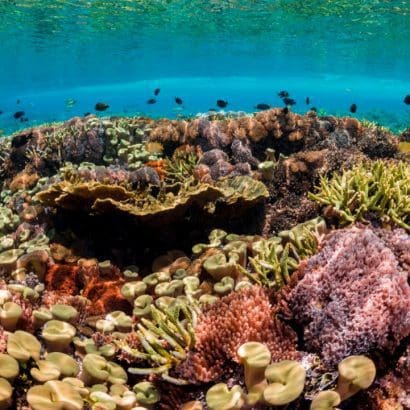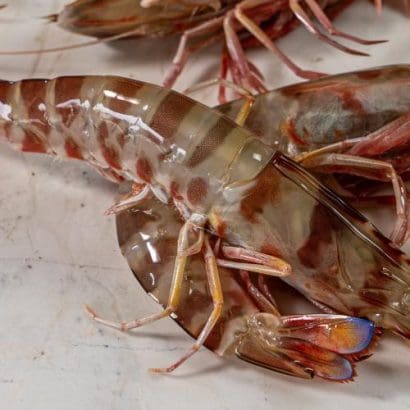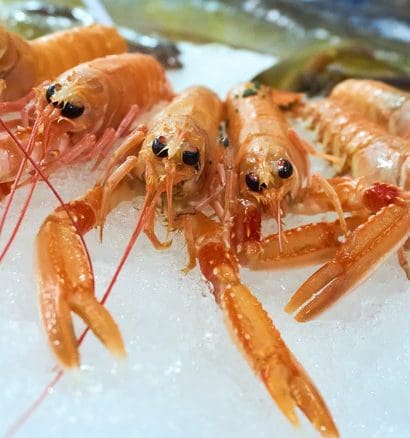
Langostinos, also known as langoustines or Norway lobsters, are fascinating crustaceans that hold a prominent place in the world of gastronomy. With their delicate flavor and succulent meat, langostinos have become a highly sought-after ingredient in various cuisines. In this article, we will delve into the intriguing world of langostinos, exploring their life cycle, methods of fishing, and their versatile uses in the culinary realm.
Understanding the life cycle of langostinos is key to appreciating their journey from tiny eggs to fully grown adults. We will explore the different stages, including their development as eggs, transformation into larvae, progression to the juvenile phase, and their eventual maturity as adult langostinos. By delving into the intricacies of their life cycle, we gain insight into the challenges and factors that influence their growth.
Contents
Life Cycle of Langostinos.
The life cycle of langostinos is a fascinating journey that takes these crustaceans from their humble beginnings as tiny eggs to their full-grown adult form. Understanding their life cycle provides valuable insights into their growth, development, and reproduction. Here is a general overview of the different stages of the langostino life cycle: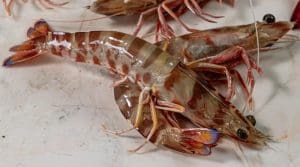
Eggs:
The life cycle begins when female langostinos release eggs into the water. These eggs are typically carried by ocean currents, allowing for their dispersal. The number of eggs produced by a single female can vary, ranging from hundreds to thousands.
Larvae:
Once the eggs hatch, the langostinos enter the larval stage. The larvae are transparent and small, measuring just a few millimeters in length. During this phase, they undergo various molting stages, shedding their exoskeleton as they grow.
Juvenile Stage:
As the larvae continue to grow and develop, they gradually transition into the juvenile stage. The juveniles resemble miniature versions of adult langostinos but are still smaller in size. This stage is crucial for their development and maturation.
Adult Stage:
After several molting cycles, the langostinos reach adulthood. They have now achieved their full size and sexual maturity. Adult langostinos typically measure around 15 to 20 centimeters in length, with a distinctive elongated body and long, slender pincers.
Fishing of Langostinos.
The fishing of langostinos is a significant activity that involves harvesting these prized crustaceans from their natural habitats. Langostino fishing methods vary depending on geographical locations, local regulations, and the specific needs of the fishing industry. Here is some general information about the fishing of langostinos: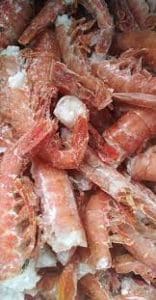
Traditional Methods:
Traditional langostino fishing methods often involve the use of traps or pots. These traps are designed to attract langostinos with bait and capture them alive. The traps are typically placed on the seabed, and langostinos are lured inside by the scent of the bait. Once trapped, the langostinos can be hauled up to the surface and collected.
Trawling:
In some areas, trawling techniques may be employed to catch langostinos. Trawlers drag large nets along the ocean floor, capturing langostinos along with other marine species. This method is more commonly used in commercial fishing operations with larger vessels.
Geographic Considerations:
The fishing of langostinos is carried out in various regions around the world, including coastal areas of Europe, North America, and Asia. Different species of langostinos may be targeted depending on the location, such as the European langoustine (Nephrops norvegicus) or the American lobster (Homarus americanus).
Sustainable Practices:
Due to the high demand for langostinos and concerns about overfishing, sustainable fishing practices have become increasingly important. Many fisheries implement measures such as catch limits, size restrictions, and seasonal closures to protect langostino populations and maintain their long-term sustainability.
Regulation and Management:
The fishing of langostinos is often regulated by local authorities and fisheries management organizations. These regulations aim to ensure that fishing activities are conducted responsibly and in accordance with conservation goals. Monitoring, licensing, and reporting requirements help track catch levels and enforce compliance.
Bycatch and Ecosystem Impact:
Like any fishing activity, langostino fishing can have unintended consequences, such as bycatch. Bycatch refers to the unintentional capture of non-target species during the fishing process. To minimize the impact on the ecosystem, efforts are made to reduce bycatch and employ selective fishing methods.
It is essential for langostino fisheries to strike a balance between meeting the demand for these delicacies and maintaining sustainable practices to safeguard langostino populations and their habitats. Sustainable fishing practices, responsible management, and scientific research are crucial components in ensuring the long-term viability of langostino fishing operations.
Culinary Uses of Langostinos.
Langostinos are highly prized in the culinary world for their delicate flavor, tender texture, and versatility in a wide range of dishes. Their unique taste and appealing appearance have made them a popular choice for various culinary creations. Here is some general information about the culinary uses of langostinos:
Culinary Preparations:
Langostinos can be prepared in numerous ways to showcase their exquisite flavor. They are commonly boiled, grilled, sautéed, or steamed. These cooking methods help to preserve their natural sweetness and succulence, resulting in a delightful dining experience.
Standalone Dishes:
Langostinos often take center stage as standalone dishes, allowing their natural flavors to shine. They can be served as a main course, accompanied by a variety of sauces, herbs, or spices. Grilled langostinos with a squeeze of lemon or garlic-infused butter are popular options that highlight their natural sweetness.
Seafood Medleys:
Langostinos are frequently incorporated into seafood medleys or mixed seafood dishes, adding an element of elegance and flavor complexity. They pair well with other seafood such as shrimp, scallops, or fish, creating a delightful combination of textures and flavors.
Pasta and Rice Dishes:
Langostinos are a fantastic addition to pasta and rice dishes, lending a touch of sophistication. They can be incorporated into creamy pasta dishes, risottos, or paellas, infusing the dish with their distinct taste and enhancing its overall appeal.
Appetizers and Starters:
Langostinos are often featured in appetizers and starters, offering a tantalizing introduction to a meal. They can be used in salads, seafood cocktails, ceviches, or as a filling for small pastries or dumplings. These appetizers allow diners to savor the delicate flavors of langostinos in a bite-sized format.
International Cuisine:
Langostinos are celebrated in various international cuisines. From Mediterranean-inspired dishes to Asian stir-fries, they lend themselves well to a wide range of culinary traditions. Whether in Spanish paella, Italian pasta, Thai curry, or French bisque, langostinos bring a touch of elegance and flavor to global gastronomy.
Nutritional Benefits:
Besides their delectable taste, langostinos offer nutritional benefits. They are a good source of lean protein and contain essential vitamins and minerals, including selenium, zinc, and vitamin B12. Additionally, langostinos are low in fat and calories, making them a healthier option in seafood-based meals.
If you are a seafood lover, I invite you to click here and discover unique recipes.
Cultivation of Langostinos.
The cultivation of langostinos, also known as langoustines or Norway lobsters, refers to the practice of raising these crustaceans in controlled environments such as aquaculture facilities. Langostino cultivation has gained popularity as a means to meet the growing demand for these delicacies while reducing the pressure on wild populations. Here is some general information about the cultivation of langostinos: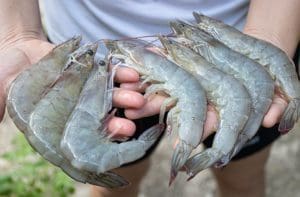
Aquaculture Techniques:
Langostino cultivation involves various aquaculture techniques to provide optimal conditions for their growth. These techniques include the use of ponds, tanks, or recirculating aquaculture systems (RAS) that ensure water quality, temperature control, and feeding management to promote healthy langostino growth.
Larval Rearing:
The cultivation process often begins with the collection of langostino larvae from the wild or the use of broodstock in controlled environments. The larvae are reared in specially designed tanks with controlled water conditions and provided with a suitable diet to support their development into juveniles.
Nursery Phase:
After the larval stage, the langostinos enter the nursery phase, where they are transferred to larger tanks or ponds. Here, they continue to grow and develop under carefully monitored conditions. The nursery phase allows for further growth and prepares the langostinos for the next stages of cultivation.
Grow-out Phase:
Once the langostinos reach a certain size in the nursery phase, they are moved to larger grow-out systems. These can include ponds, cages, or raceways, depending on the specific cultivation method. During this phase, langostinos are fed a nutritionally balanced diet, and their growth is closely monitored until they reach market size.
Harvesting:
The timing of langostino harvesting depends on the desired market size and demand. Harvesting can be done through various methods, including netting, trapping, or draining ponds. Careful handling is essential to ensure the langostinos’ quality and freshness during the harvesting process.
Sustainability and Environmental Considerations:
Langostino cultivation aims to minimize environmental impact and promote sustainable practices. Efforts are made to optimize feed utilization, reduce waste, and manage water quality to ensure the health of the langostinos and the surrounding ecosystem.
Economic and Social Importance:
Langostino cultivation not only contributes to meeting the market demand for these prized crustaceans but also provides economic opportunities for local communities. It creates jobs in the aquaculture sector and supports the sustainable development of coastal regions.
Curiosities about Langostinos.
In conclusion, langostinos offer a world of intriguing curiosities. These crustaceans, with their unique taxonomic classification, captivating molting process, and stunning color variation, continue to fascinate both scientists and seafood enthusiasts. Their ability to extract oxygen from water, nocturnal behavior, and remarkable sensory abilities showcase their remarkable adaptations for survival. Langostinos’ longevity, widespread distribution, and economic importance in gastronomy and local communities further highlight their significance. From their delicate flavor to their contribution to coastal economies, langostinos have earned their place as a fascinating and sought-after species. Exploring the curiosities surrounding langostinos adds an extra layer of appreciation for these remarkable creatures and their place in the natural world.

